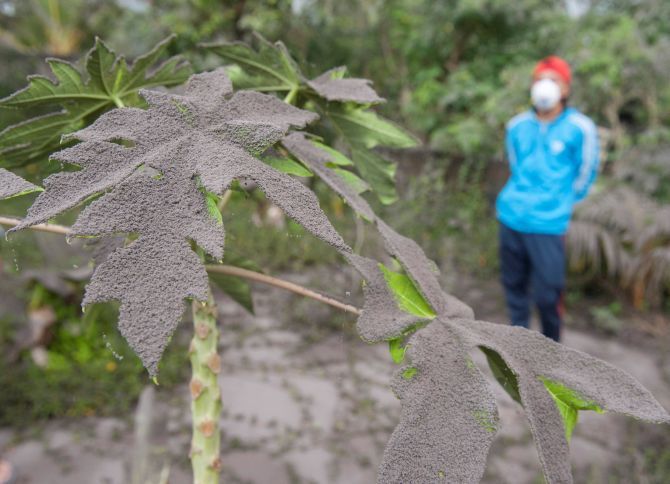 | « Back to article | Print this article |
Bali has ordered a mass evacuation and raised the volcanic eruption alert to the highest level with the island’s international airport closed for 24 hours, trapping 60,000 travellers.

Mount Agung has been hurling clouds of white and dark grey ash nearly 10,000 feet into the atmosphere since the weekend and lava is welling up in the crater.
The National Disaster Mitigation Agency raised the volcano’s alert to the highest level early on Monday warning a larger eruption is possible.

Bali’s airport was closed early today after ash, which can pose a deadly threat to aircraft, reached its airspace. Some 445 flights were cancelled, stranding about 59,000 travellers.

Authorities say the new extension of the volcanic danger zone affects 22 villages and about 90,000 to 100,000 people. About 40,000 people have evacuated but others have not left because they feel safe or don't want to abandon their livestock.
WATCH: Bali volcano erupts
The volcano’s last major eruption in 1963 killed about 1,100 people.

Bali is Indonesia’s top tourist destination, with its gentle Hindu culture, surf beaches and lush green interior attracting about 5 million visitors a year.

The ash, which began spewing into the sky after Mount Agung in eastern Bali erupted three times Saturday, has reached heights of 4,000 metres, according to Sutopo Purwo Nugroho, head of information and data for Indonesia's National Disaster Management Agency.

According to Australia's Bureau of Meteorology, by Monday morning the continuous cloud of smoke had reached as high as 9,100 metre.
The first eruption came around 5:30 pm on Saturday, Bali’s Regional Disaster Management Agency said. More eruptions followed and continued into Sunday, with a “medium-pressure eruption” in the early evening.

>> Mt Tambora, Indonesia, 1815
Mount Tambora is the deadliest eruption in recent human history, claiming the lives of up to 120,000 people. On 10 April 1815, Tambora erupted sending volcanic ash 40 km into the sky. It was the most powerful eruption in 500 years.
>> Krakatoa, Indonesia, 1883
The eruption of the Indonesian volcano, Krakatoa, was one of the most violent eruptions in recent human history - completely destroying the island on which it resides.
On the morning of August 27, a series of massive eruptions tore the volcano’s walls apart. Krakatoa’s final eruption was four times more powerful than the largest bomb that humans have detonated.
Its airwaves travelled seven times around the globe. It produced a series of tsunamis that devastated the region, killing around 36,000 people and destroying whole villages. Some have estimated the cost of the eruption to be as high as $1.5 billion.
>> Laki, Iceland, 1783
The devastation of the Laki eruption was felt globally for years after the event. The Laki eruption lasted for 8 months, emitting about 14.7km3 of lava. Toxic gases poisoned crops and killed 60 per cent of Iceland’s grazing livestock. The volcano released enough SO2 to cause acid rain and global temperatures to drop. The eruption resulted in a famine that killed over 10,000 Icelandic people, roughly a quarter of the country’s population at the time.
>> Mt Pelee, Caribbean, 1902
Until Mt Pelee produced the worst eruption of the 20th century, the volcano was thought to be dormant. On May 8, Mt Pelee exploded hot gas and volcanic debris, destroying the entire city of St Pierre. Of the 28,000 people living in St. Pierre, only two survived. The cost of the eruption was estimated at $50 million.
>> Mount Pinatubo, Philippines, 1991
The Mount Pinatubo eruption was the second largest volcanic eruption of the 20th century. On June 15, the volcano erupted, creating an ash cloud that rose 3 5km into the air. The eruption created massive avalanches of pyroclastic flows and ejected nearly 20 million tons of SO2 into the stratosphere, causing global temperatures to plummet. While only 722 were killed, the eruption left more than 200,000 people homeless. The eruption cost upwards of $200 million.
>> Mt Vesuvius, Italy, 79 AD
Mt Vesuvius has erupted several times in human history, however, the terrifying eruption of 79 AD is the most well known. On August 24, Vesuvius erupted ash, mud and toxic gases, completely burying the nearby cities of Pompeii and Herculaneum. The eruption killed 16,000 people. It took until 1595 for the cities to be excavated and rediscovered. If the same eruption occurred today it would cost in the billions.